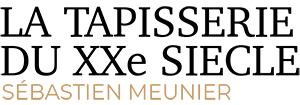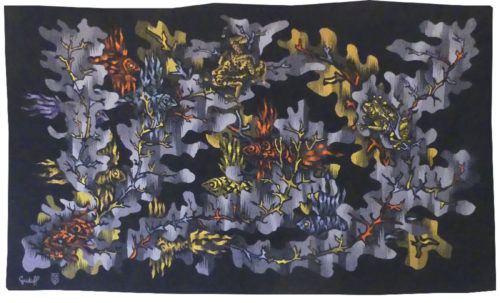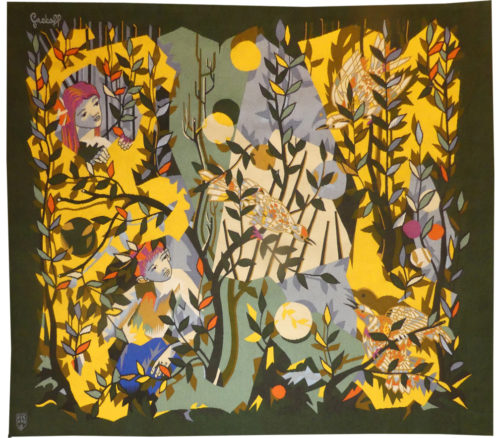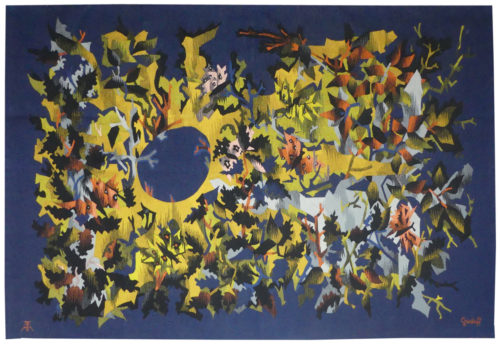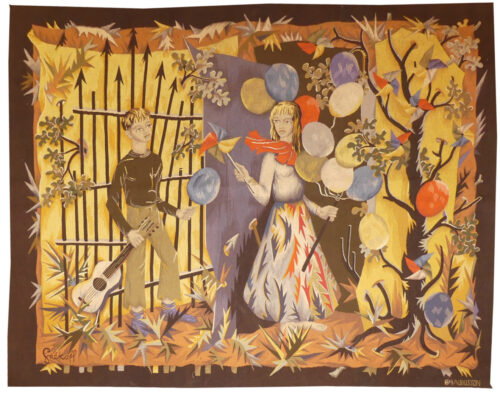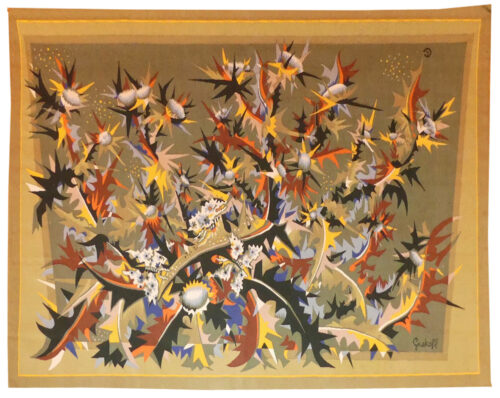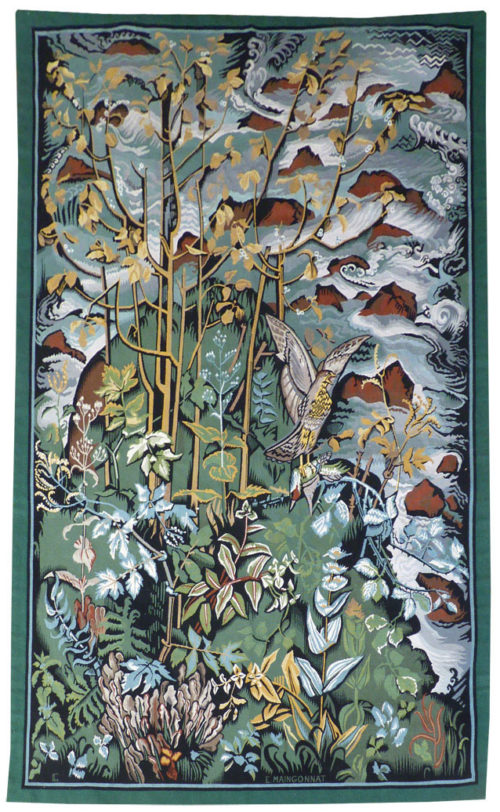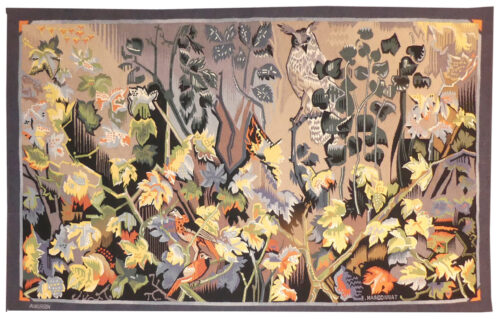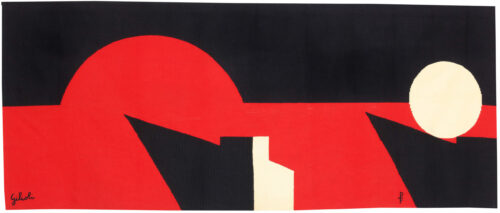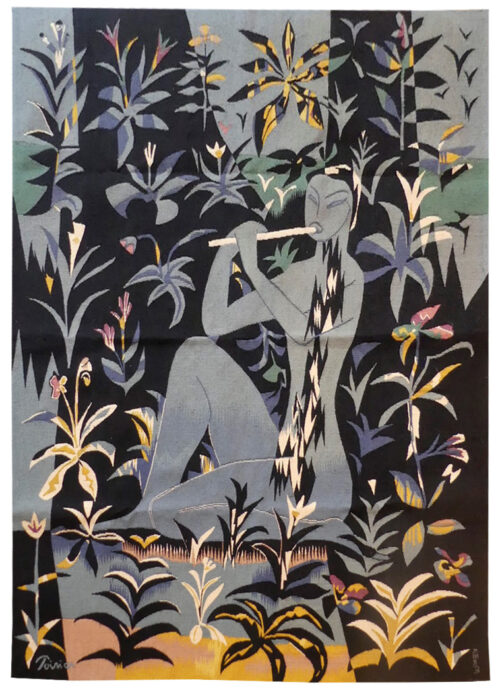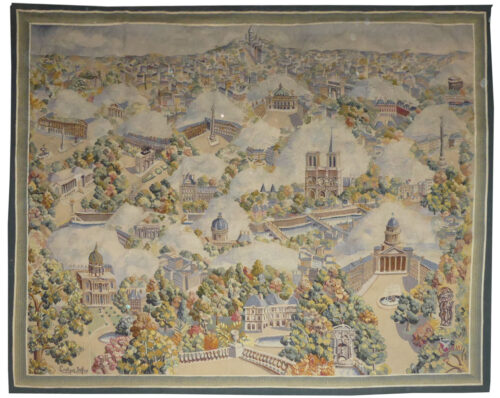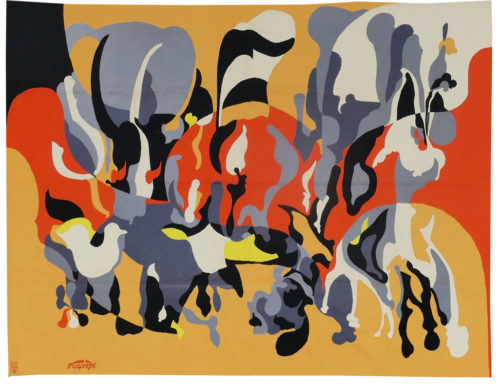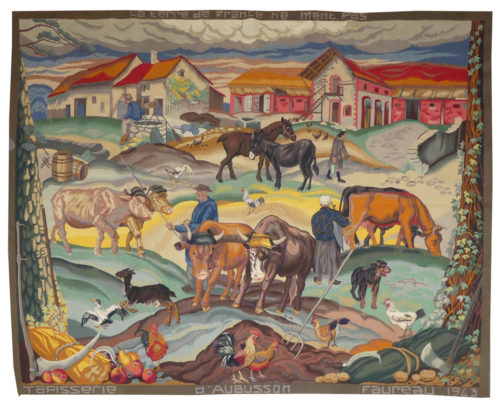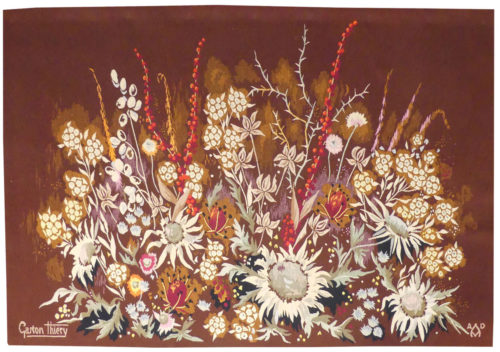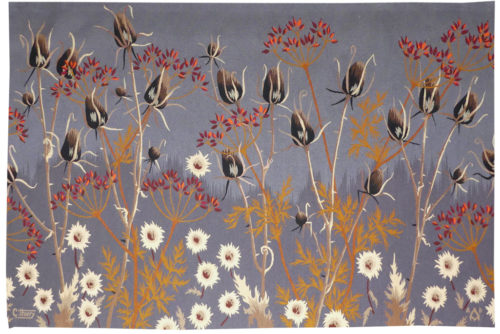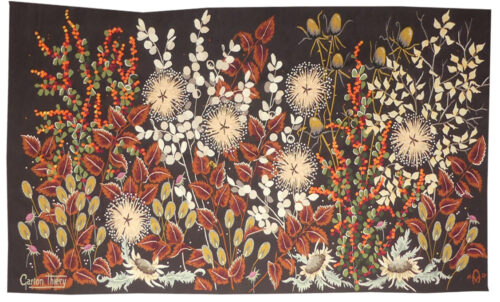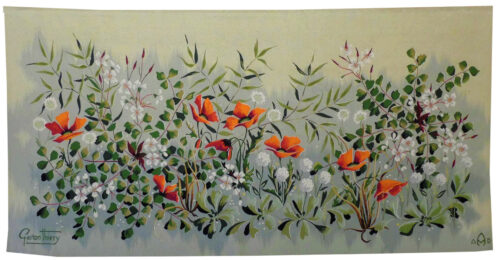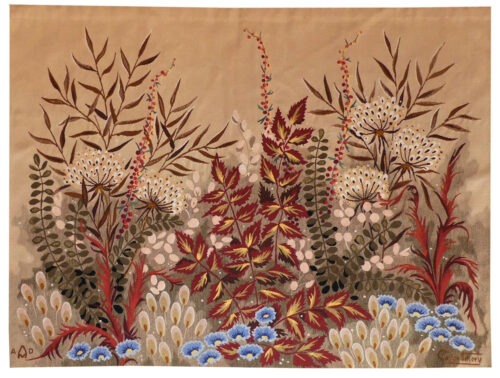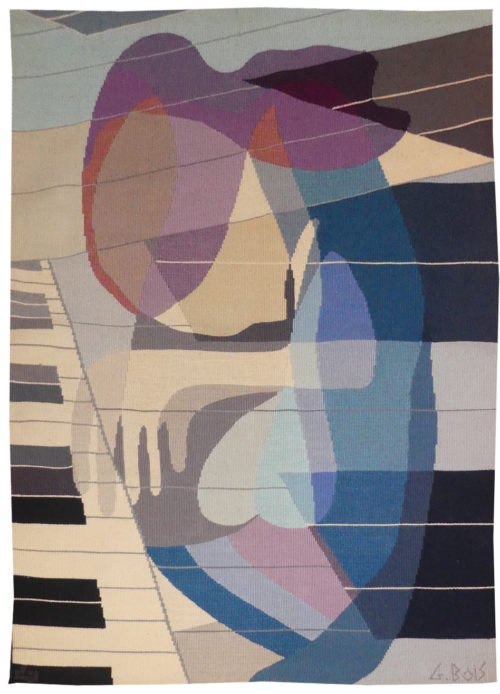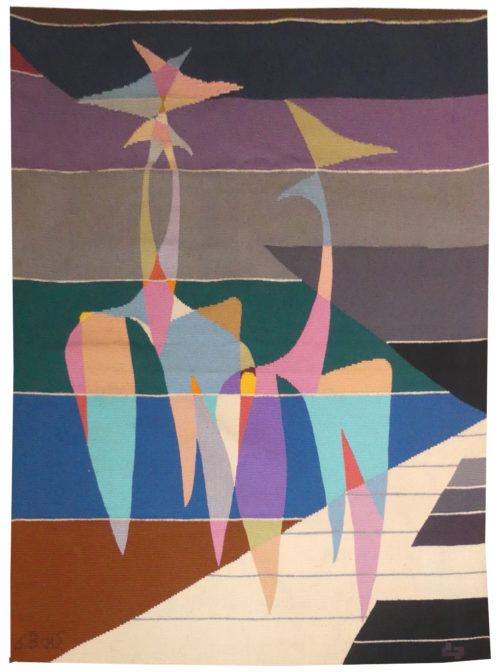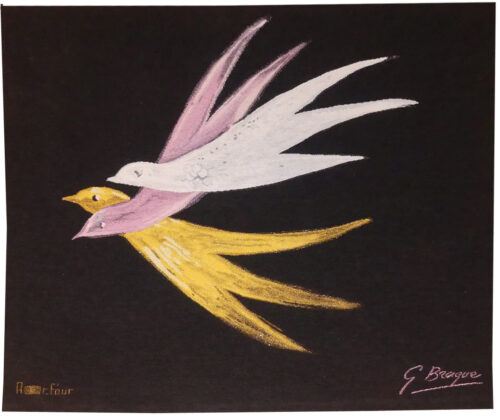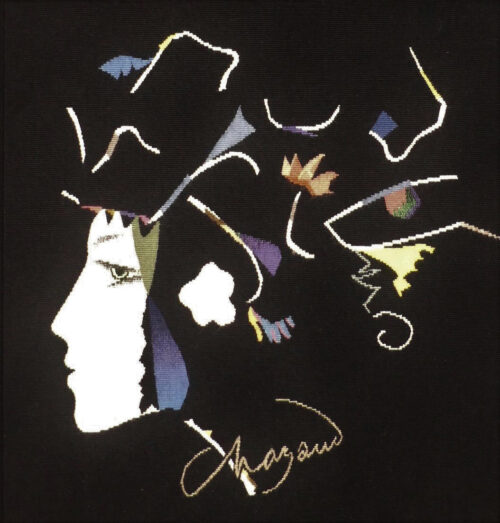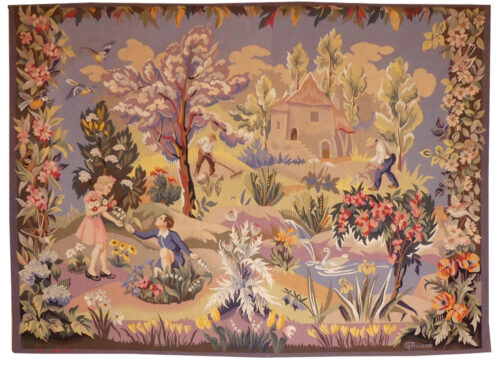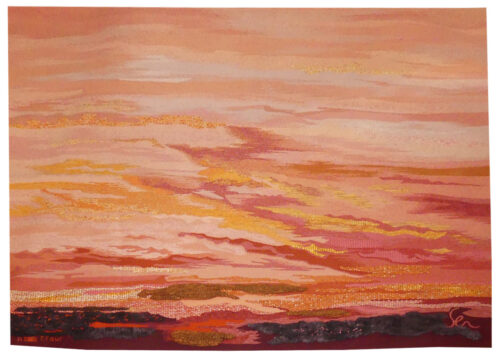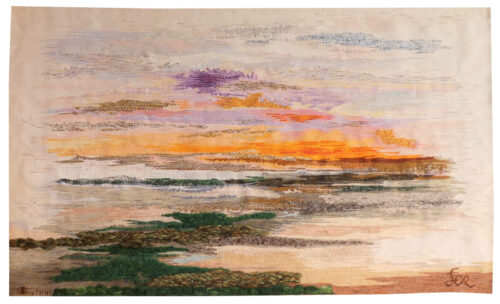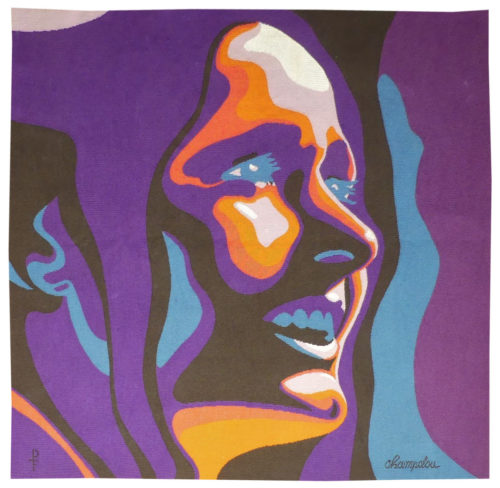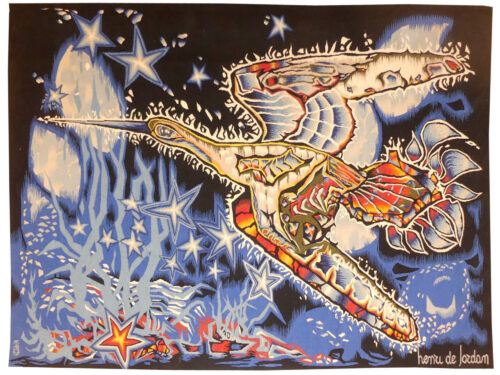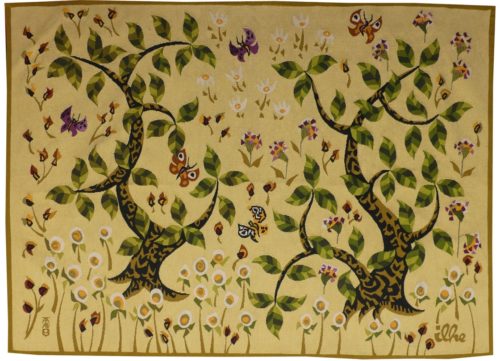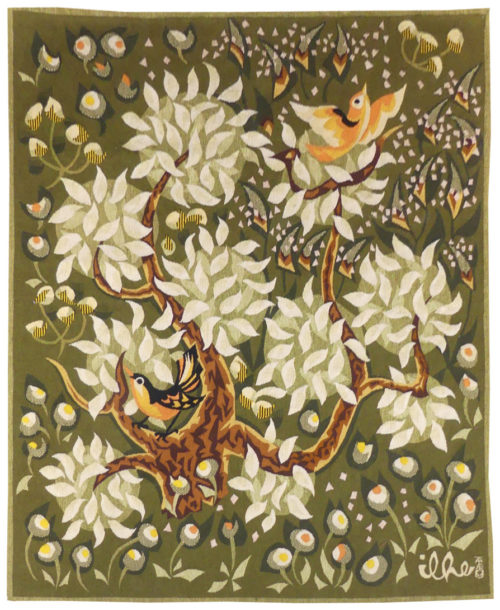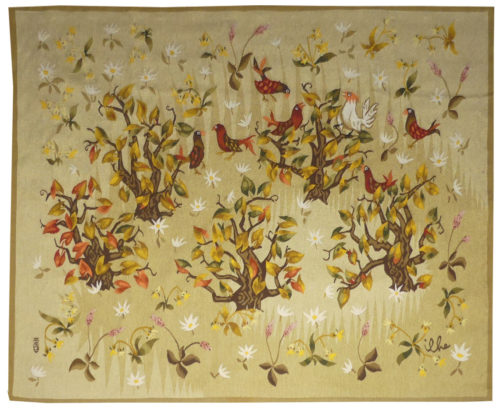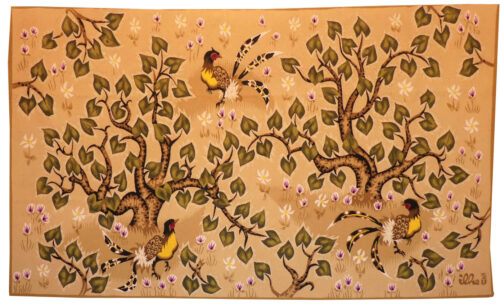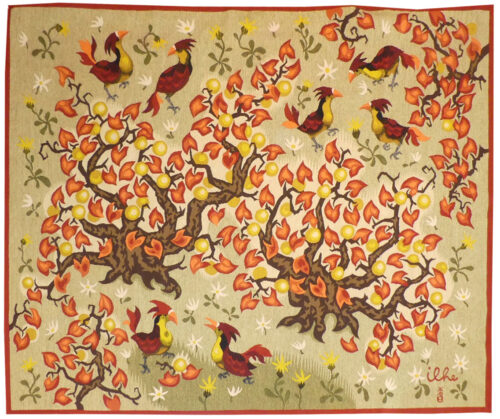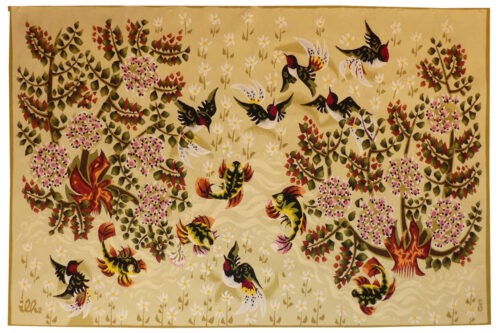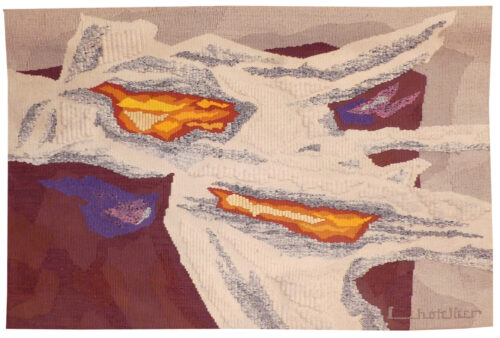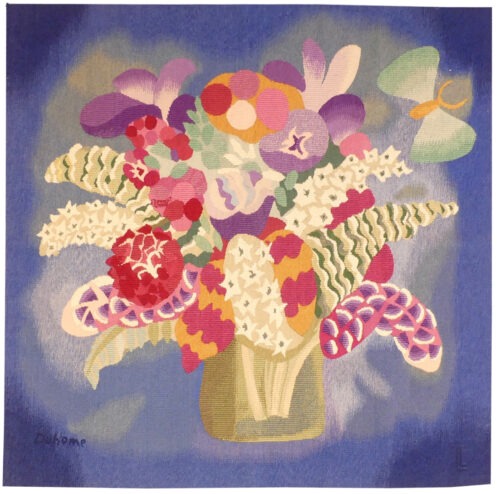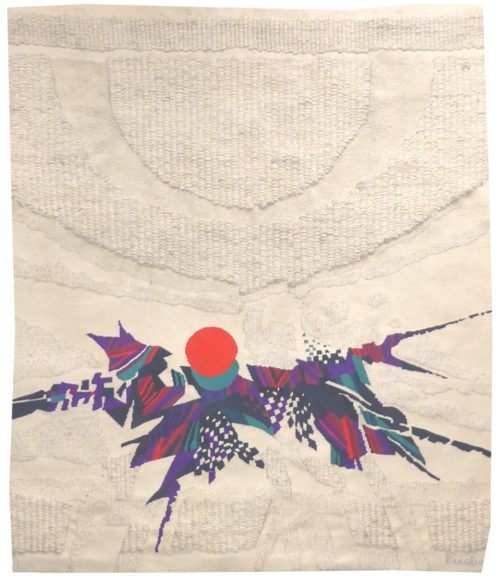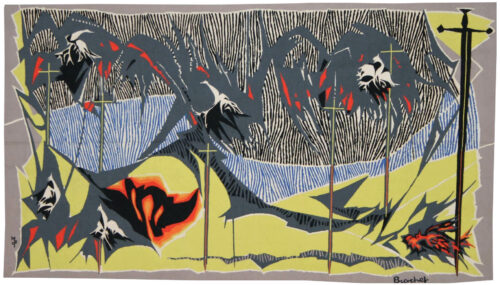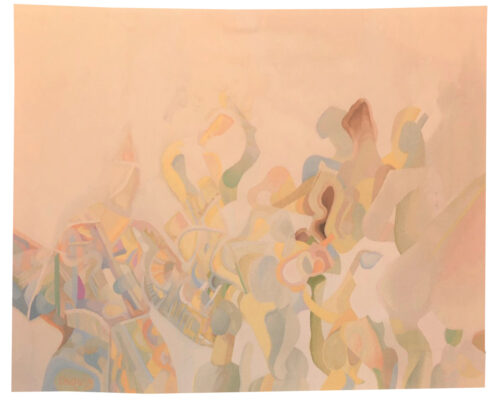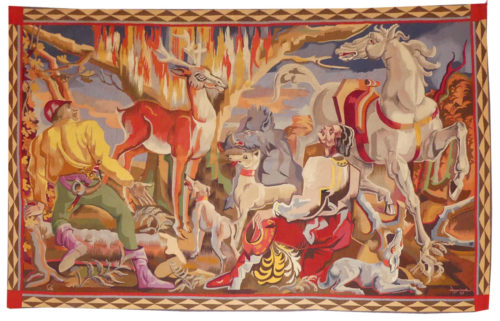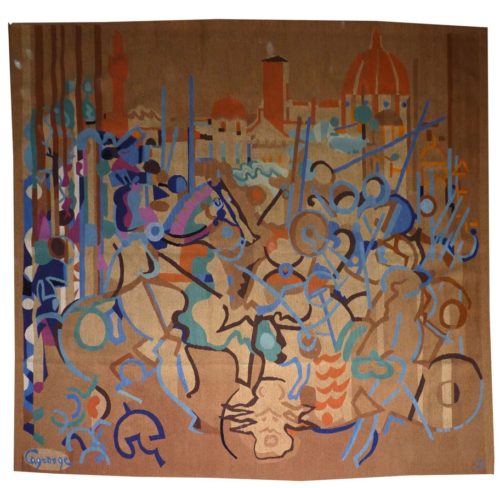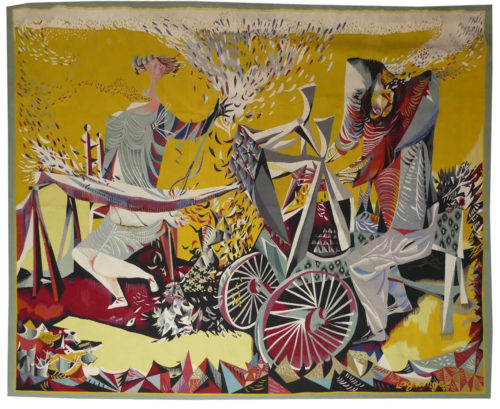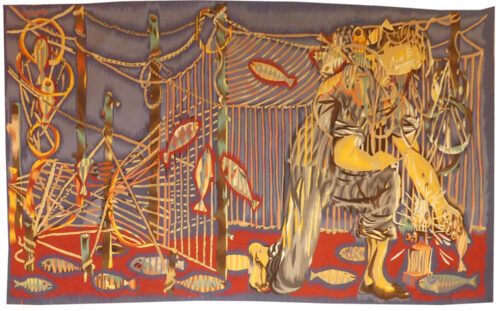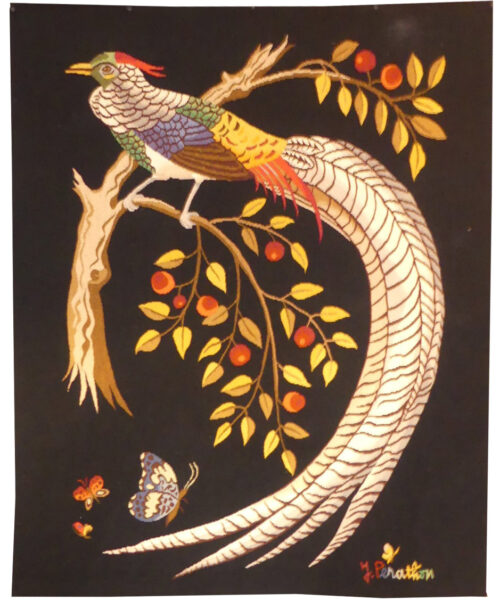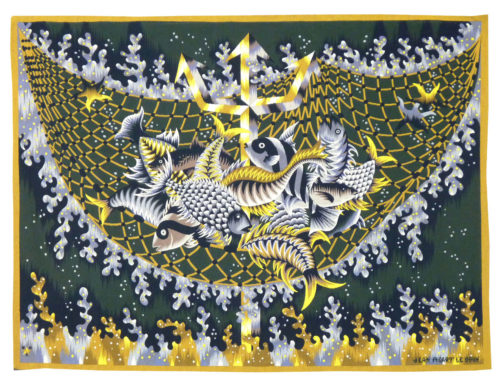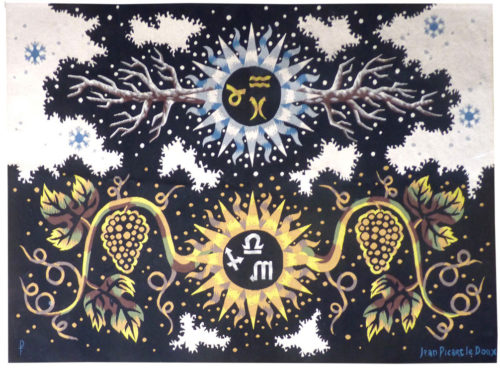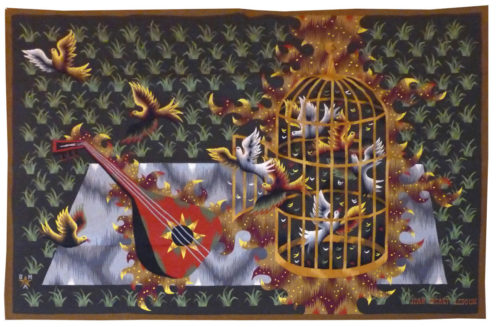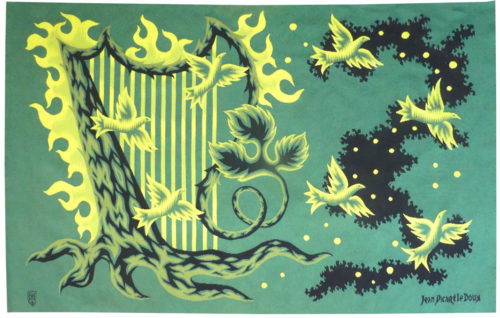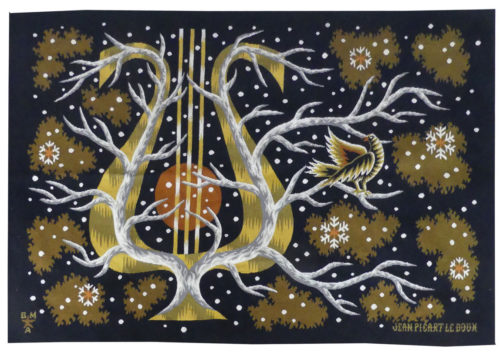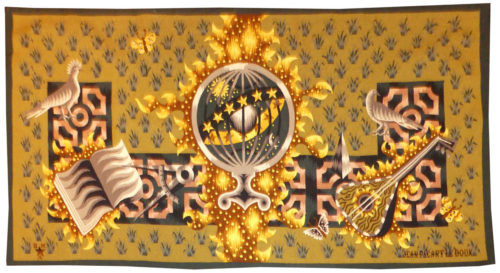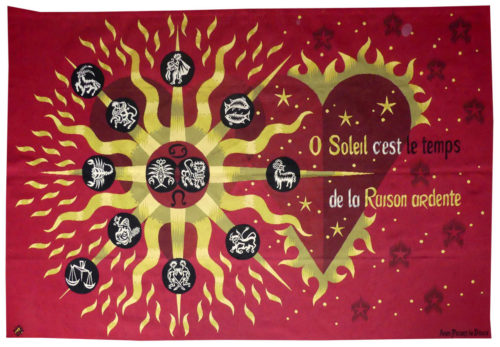-
Aubusson tapestry woven by the Picaud workshop. With label, n°1/6. Circa 1970.Elie Grekoff, whose aesthetic is similar to that of Lurçat, designed over 300 cartons.“The little bird catcher” is typical of a vein characteristic of Grekoff where melancholic children consider each other within a dream-like landscape against a background of large flat areas of colour, redolent of an illustration for a folk tale.
-
Paysage bleu aux papillons (blue landscape with butterflies)
Elie Grekoff, whose aesthetic is similar to that of Lurçat, designed over 300 cartons : here we find evidence of the artist’s evolution from the 1960’s onwards, as the human or animal figures disappear from his work. The recurrent theme is one where a heavenl_ bod_ (the sun, the moon) appears half-hidden behind foliage.Tapestry woven by the ATA (Atelier de Tapisserie d'Angers). With signed label, n°1/4. Circa 1970. -
Marchande d'illusions (the dream vendor)
Elie Grekoff, whose aesthetic is similar to that of Lurçat, designed over 300 cartons “The dream vendor” is typical of a vein characteristic of Grekoff where melancholic children consider each other, as in a scene on a stage, redolent of an illustration for a folk tale.Aubusson tapestry woven by the Pinton workshop. With label. Circa 1955. -
Chardons aux papillons blancs (Thistles with white butterflies)
Elie Grekoff, whose aesthetic is similar to that of Lurçat, designed over 300 cartons until the early 1980s. Here we find the sharp shapes typical of tapestry in the immediate post-war period. Note the motif which, amusingly enough, goes beyond the border-frame.Aubusson tapestry woven by the Caron workshop. With signed label, n°EA. Circa 1970. -
le tiercelet (the sparrow hawk)
Aubusson tapestry woven by the Legoueix workshop. Complete with certificate of origin signed by the artist's beneficiary, n° E.A.1 1942. Elie Maingonnat governed the Ecole Nationale des Arts Décoratifs d’Aubusson from 1930 until 1958 where he took over from Marium Martin (who already recommended the use of a limited number of colours and the use of hachures, a similar technique to hatching) of whom he was a pupil. As well as assuming the responsibilities of his position, Maingonnat devoted himself to designing cartoons : motifs of dense vegetation animated by the presence of a few animals, both of which were inspired by the flora and fauna of the Limousin area of France revitalising the traditional theme of greenery used in the XVIIth and XVIIIth centuries. This cartoon is typical of Maingonnat’s work : local flora and fauna (here a diminutive sparrow hawk among gentians on the bank of a mountain stream) are illustrated in a limited grey-green spectrum which is reflected and emphasised by the browns of the stones in the river. Bibliographie : Exhibition Catalogue Elie Maingonnat, Aubusson, Musée départemental de la tapisserie, 1986-1987, Ill. -
Le hibou (the owl)
Elie Maingonnat governed the Ecole Nationale des Arts Décoratifs d’Aubusson from 1930 until 1958 where he took over from Marium Martin (who already recommended the use of a limited number of colours and the use of hachures, a similar technique to hatching) of whom he was a pupil. As well as assuming the responsibilities of his position, Maingonnat devoted himself to designing cartoons : motifs of dense vegetation animated by the presence of a few animals, both of which were inspired by the flora and fauna of the Limousin area of France revitalising the traditional theme of the Aubusson "verdures" used in the XVIIth and XVIIIth centuries. Our carton is typical of Maingonnat's work: the local flora and fauna, as if in symbiosis, are illustrated in a reduced range of autumnal colours. Bibliography : Exhibition catalogue Elie Maingonnat, Aubusson, Musée départemental de la Tapisserie, 1986-1987Aubusson tapestry woven by the Avignon workshop. With label signed by the artist's beneficiary. 1959. -
Le périscope (the periscope)
“First of all I like wool, its warmth...In tapestry, I can use both colour and graphic design” wrote the artist in “Sculpture”, Paris, 1968. Better known as a sculptor, Gilioli would design his first cartoon in 1949, before winning in 1957 the Tapestry Prize at the Biennial in Sao Paulo ; in all he designed around a hundred tapestries, woven by the Pinton and Picaud workshops. From the end of the 1960’s onwards Gilioli’s cartoons are exclusively geometrical, use two or three colours and evolve in parallel with the forms employed in other media. Our tapestry reproduces, on a smaller scale, the mosaic designed a few years earlier by the artist for the building “Le Périscope,” a project by Novarina in the 13th arrondissement of Paris. Bibliography : Exhibition catalogue Gilioli, Paris, Galerie la Demeure, 1971 Exhibition catalogue Des sculpteurs et la Tapisserie, Angers, Musée Jean Lurçat et de la Tapisserie Contemporaine, 1995 Exhibition catalogue Gilioli Tapisseries, Paris, Fondation Dina Vierny, 1997Aubusson tapestry woven in the Pinton workshop. With signed label, n°1/6. 1971. -
Sérénade à la lune (moon serenade)
Aubusson tapestry woven by the Braquenié workshop. N°IV/VI. 1952.Initiated into the art of tapestry design by Jean Picart le Doux, Poirier produced his first cartoon in 1951 : he was to produce twenty-odd cartoons during the 1950's, which led him to be considered as one of the great hopes for the new Tapestry movement. However from the 60's onwards, he returned to painting. ‘Sérénade à la lune’ was originally a large-scale cartoon (190 x 285 cm) commissioned by Jacques Adnet in 1952. Our tapestry uses the left-hand side of the composition, reduced in height and inverted, without the moon. This fragmentation met the needs of a clientele eager for small formats. Bibliography : J. Cassou, M. Damain, R. Moutard-Uldry, la tapisserie française et les peintres cartonniers, Tel, 1957, ill. p.182 -
Paris moderne (modern Paris)
Little is known about the artist, but she created a number of cartoons, which would be woven by Antoine Behna’s ART workshop. The panoramic topographical view was one of the specialities of the workshop, “Paris moderne” being a sort of riposte to Bobot's “Vieux Paris 1650”. An example of each of these tapestries was offered as a gift to President Truman. Bibliography : G. Janneau, A. Behna, Tapisseries de notre temps, 1950, ill. n°3 Millon-Robert sale catalogue 3.10.1990 n°1, 31Tapestry woven by the Colombes workshop for ART (Atelier de Rénovation de la Tapisserie). 1945. -
Composition
Aubusson tapestry woven in the Picaud workshop. Circa 1960.Born in 1912, Farvèze is one of the second generation of painter-cartonniers whose heyday dates from the end of the 1950’s, with the likes of Grékoff, Ferréol, Petit, Potin, … Influenced both by his meeting with Gleizes and a trip to Senegal which brought prestigious state commissions, he would be chosen to participate in the second Biennale de Lausanne in 1965. This piece is characterised by a highly stylised and very colourful design ; the absence of the certificate of origin means that we have no indication of the title or subject - although various animal-shaped forms can be distinguished. -
La terre de France ne ment pas (French soil doesn't lie)
François Faureau is a singular figure. Born in Aubusson, he studied at the ENAD, of which at the time the director was Marius Martin who was already promoting the use of thick yarn and counted colours that Lurçat would later adopt. Thus he was a representative of the peintre-cartonniers at the stand of the ENAD at the Exposition internationale des Arts décoratifs in 1925 with his tapestry “Solitude, verdure” or the screen “Canards”, which hesitate between neo-classicism and the influence of cubism. He later founded his own workshop, but his production remained somewhat confidential, and somewhat removed from the protagonists of the “Tapestry Renaissance”. Although the workshops in Aubusson continued their activity during the occupation (as did the Manufactures Nationales), the production of pieces directly influenced by the imposition of the values of Pétain’s government are rare, despite the fact that this typically traditional skill undoubtedly coincided with the values of what was known at the time as the National Revolution. The famous formula spoken by Maréchal Pétain on 25th June 1940 (although its author was Emmanuel Berl), which went on to become a leitmotiv in the official public discourse, exalting the countryside, society’s peasant roots and, rather more prosaically, agriculture, is illustrated here in a very literal fashion bringing together the various rural tasks, vegetation, architecture and animals... all harmoniously exposed under the protective watch of the Vichy regime. Provenance : Collection Régine Deforges Bibliography : Exhibition catalogue Tapisseries 1925, Aubusson, Cité de la tapisserie, 2012Aubusson tapestry. 1943. -
Flore des Baronnies (Baronnies's Flora)
Aubusson tapestry woven in the Andraud workshop. With label, n°1/6. 1974.A student of Léon Detroy, Gaston Thiéry is one of the last representatives of the Crozant school of painting. Established in the Creuse region of France, he started working on tapestries in 1965 with the Andraud workshop for whom he designed cartoons inspired by the local flora, in a decorative style which can be situated somewhere between that of Dom Robert and Maingonnat, a world away from his landscape paintings which were strongly influenced by the impressionists. -
Jardin sauvage (wild garden)
A student of Léon Detroy, Gaston Thiéry is one of the last representatives of the Crozant school of painting. Estalished in the Creuse region of France, he started working on tapestries in 1965 with the Andraud workshop for whom he designed cartoons inspired by the local flora, in a decorative style which can be situated somewhere between that of Dom Robert and Maingonnat, a world away from his landscape paintings which were strongly influenced by the impressionists.Aubusson tapestry woven in the Andraud workshop. With label, n°6/8. 1970. -
Féérie automnale (automn wonder)
A student of Léon Detroy, Gaston Thiéry is one of the last representatives of the Crozant school of painting. Estalished in the Creuse region of France, he started working on tapestries in 1965 with the Andraud workshop for whom he designed cartoons inspired by the local flora, in a decorative style which can be situated somewhere between that of Dom Robert and Maingonnat, a world away from his landscape paintings which were strongly influenced by the impressionists.Aubusson tapestry woven in the Andraud workshop. With label, n°EA2. 1977. -
Kalinka
Aubusson tapestry woven in the Andraud workshop. With label, n°4/6. 1980.Established in the Creuse region of France, he started working on tapestries in 1965 with the Andraud workshop for whom he designed cartoons inspired by the local flora, in a decorative style which can be situated somewhere between that of Dom Robert and Maingonnat, a world away from his landscape paintings which were strongly influenced by the impressionists. The title of this piece, which will be evocative to lovers of folk-song, is the name (but in Russian !) of the subject illustrated : kalinka meaning guelder-rose.This tapestry is reproduced in the publication « Tapisserie d’Aubusson » produced by the Guéret Chamber of Commerce and Industry at the beginning of the 1980’s to illustrate the technical prowess of the Aubusson tapestry workshops. -
Clos d'octobre (october enclosure)
Aubusson tapestry woven in the Andraud workshop. With label, n°EA2. 1978.A student of Léon Detroy, Gaston Thiéry is one of the last representatives of the Crozant school of painting. Estalished in the Creuse region of France, he started working on tapestries in 1965 with the Andraud workshop for whom he designed cartoons inspired by the local flora, in a decorative style which can be situated somewhere between that of Dom Robert and Maingonnat, a world away from his landscape paintings which were strongly influenced by the impressionists. -
Concerto
Tapestry woven by the Saint-Cyr workshop. With signed label, n°1/6. Circa 1970. An unknown artist, whose inspiration finds its source in the instruments and theory of Music ; a geometric evocation of a keyboard and the stave serve as a framework for the cartoon. -
Figure de trois (Triplet)
Tapestry woven by the Saint-Cyr workshop. With signed label, n°1/6. Circa 1970. An unknown artist, whose inspiration finds its source in the instruments and theory of Music ; a geometric evocation of a keyboard and the stave serve as a framework for the cartoon. -
Les 3 Grâces (the 3 Graces)
Braque is another 20th century artist who produced, however modestly, works in tapestry form. It was originally at the request of Marie Cuttoli in 1933, that he submitted works for reproduction as tapestries (Nature morte au guéridon [Still life on an occasional table], conserved at the Musée des Beaux Arts in Grenoble). In the 1950’s and 60’s it was Pierre Baudouin, in association with the weavers of Aubusson and the Nationale Manufactures, who would be asked to transcribe to cartoon format some of the artist’s productions. At the same time, shortly before his death in 1963, Braque made a last series of images in gouache, taking as their theme metamorphoses, which were destined for reproduction in various different media. Tapestry would be one of these. “The three graces”, 1962, is one which would appear in sculpture, or as jewelry. In it we observe the lyrical and synthetic style to be found in the artist’s last works (obviously the decor of the ceiling in the Henri II room at the Louvre, les Oiseaux [the birds] 1953 comes to mind).Aubusson tapestry woven by the Four workshop. N°3/6. Woven circa 2000, after a 1962 gouache. -
Visage (face)
Chazaud, originally from the Creuse department of France, revealed in his tapestries the extent of his affection for the natural world in which he grew up and which he, like Gaston Thiéry (and Maingonnat before them) largely drew on for inspiration. The female form is, however, another thematic inspiration for Chazaud; with his flower-women, his leaf-women, he reintroduces the human face and profile to the art of tapestry.Tapestry probably woven in the Picaud workshop in Aubusson. Circa 1980. -
Idylle pastorale (pastoral idyll)
Georges Rougier, who taught drawing at school in Aubusson, produced numerous cartoons for the Aubusson workshops and the Mobilier National, and worked alongside Marius Martin when he was head of ENAD. Along with Maingonnat and Faureau, Martin made him one of the main protagonists of a pictorial aesthetic resolutely turned towards tapestry, which was expressed in particular at the Exposition Internationale des Arts Décoratifs in Paris in 1925 (Rougier also had his own stand there!). Bibliography : Exhibition Catalogue « Tapisseries 1925. Aubusson, Beauvais, les Gobelins à l’Exposition Internationale des Arts Décoratifs de Paris », Aubusson, Cité de la Tapisserie, 2012Aubusson tapestry. Circa 1930. -
Sirocco
Despite considering herself first and foremost a sculptor, Hedva Ser also produced some cartoons, woven at the Four workshop in Aubusson, which evoke atmospheric scenes (there are also “Esterel”, “Pampa”, “Océan”...), where clouds, reflections, waves and dunes... are represented by the effective use of different threads and stitches.Aubusson tapestry woven by the Four workshop. N°2/6. Circa 1990. -
Pampa
Aubusson tapestry woven by the Four workshop. With label, n°2/6. Circa 1990.Despite considering herself first and foremost a sculptor, Hedva Ser also produced some cartoons, woven at the Four workshop in Aubusson, which evoke atmospheric scenes (there are also “Esterel”, “Sinaï”, “Océan”...), where clouds, reflections, waves and dunes... are represented by the effective use of different threads and stitches. -
Portrait
Aubusson tapestry woven by the Pinton workshop. With label, n°1/6. Circa 1980.Doubtless a tapestry woven from a work by Hélène Champaloux (with an X !), in a style reminiscent of posters of the 1970’s, featuring a face treated as if by solarization : a very rare subject for a tapestry! -
Composition
Aubusson tapestry woven in the Henry workshop. With signed label, n°1/1. 1984.Like other sculptors (Gilioli, Adam, Ubac...), Hairabédian turned to tapestry (his studio was located in Creuse from 1975 to 1985). In the absence of volume, his spectacular composition plays on the size of weaving stitches, the hollowing out of space with the blank warp... processes typical of the ‘New Tapestry’. -
L'oiseau de rêve (the dream bird)
A local boy, Henri de Jordan met Firmin Bauby in Perpignan, the man behind the San Vicens ceramics workshop. It was there that he discovered painting on ceramics, as well as tapestry, through Lurçat and Picart le Doux. Our cartoon bears witness to this influence: it is the work of a young artist still marked by the tutelary shadow of his elders (Lurçat died that same year).Aubusson tapestry woven in the Tabard workshop. With signed label. 1966. -
Petit bois (grove)
Aubusson tapestry woven in the Tabard workshop. With label, signed by the artist. Circa 1970. Henri Ilhe, who came to the design of tapestry cartoons late on in his career, still managed to produce from 1964 onwards a considerable number (more than 120, all woven by the Tabard workshop) in an urbane style, incorporating birds and butterflies sporting in and around the gnarled branches of trees and bushes. “Petit bois” is thus, characteristic of Ilhe’s bucolic inspiration. -
Matines (matins)
Henri Ilhe, who came to the design of tapestry cartoons late on in his career, still managed to produce from 1964 onwards a considerable number (more than 120, all woven by the Tabard workshop) in an urbane style, incorporating birds and butterflies sporting in and around the gnarled branches of trees and bushes. The title of this piece evokes a certain community of spirit with Dom Robert in the mingling of rural concerns and monastic life.Aubusson tapestry woven in the Tabard workshop. With signed label, n°5. Circa 1970. -
Le merle blanc (the white blackbird)
Henri Ilhe, who came to the design of tapestry cartoons late on in his career, still managed to produce from 1964 onwards a considerable number (more than 120, all woven by the Tabard workshop) in an urbane style, incorporating birds and butterflies sporting in and around the gnarled branches of trees and bushes. With this representation of a bird whose rarity value is equal to that of a five-legged sheep, Ilhe expresses no ornithological pretention, merely an illustration of the natural world as a collection of singular phenomena.Aubusson tapestry woven in the Tabard workshop. With signed label. Circa 1965. -
Chantelune
Henri Ilhe, who came to the design of tapestry cartoons late on in his career, still managed to produce from 1964 onwards a considerable number (more than 120, all woven by the Tabard workshop) in an urbane style, incorporating birds and butterflies sporting in and around the gnarled branches of trees and bushes. “Chantelune” is thus, characteristic of Ilhe’s bucolic inspiration.Aubusson tapestry woven in the Tabard workshop. With signed label, n°EA II. Circa 1970. -
Les fruits d'or (the golden fruits)
Aubusson tapestry woven in the Tabard workshop. With signed label. Circa 1965.Henri Ilhe, who came to the design of tapestry cartoons late on in his career, still managed to produce from 1964 onwards a considerable number (more than 120, all woven by the Tabard workshop) in an urbane style, incorporating birds and butterflies sporting in and around the gnarled branches of trees and bushes. “Les fruits d'or” is thus, characteristic of Ilhe’s bucolic inspiration. -
Laissez les vivre (let them live)
Aubusson tapestry woven in the Tabard workshop. With signed label, n°6/8. Circa 1970.Henri Ilhe, who came to the design of tapestry cartoons late on in his career, still managed to produce from 1964 onwards a considerable number (more than 120, all woven by the Tabard workshop) in an urbane style, incorporating birds and butterflies sporting in and around the gnarled branches of trees and bushes. “Laissez les livre” is thus, characteristic of Ilhe’s bucolic inspiration. -
Roc neige (rock snow)
Tapestry woven by the L.M. workshop in Calais. With signed label, n°EA1. Circa 1970.A glassmaker (he designed many stained glass windows for public buildings, particularly in the Boulonnais region), engraver, painter and photographer, Lhotellier had many strings to his bow. Typical of his work from around 1970, our tapestry bears witness to the existence of little-known weaving workshops capable of accomplished creations, far from what was being done in Aubusson at the time. -
Bouquet papillon (bunch butterfly)
Aubusson tapestry woven in the Legoueix workshop. With signed label, n°4/6. Circa 1980.From illustration to tapestry, there's only one (big) step to take - remember that Dom Robert was an illuminator! It was he, and Madeleine David, one of the co-directors of the La Demeure gallery, with whom she was close, that encouraged Jacqueline Duhême to take up the medium: preceded by her reputation as an “imagière” (cf. bibliography), illustrating Prévert, Eluard and Druon, she devoted herself to tapestry from 1967 (when she took classes with Tourlière at the ENAD in Aubusson, and became an enthusiast of numbered cartoons) to 1981, with La Demeure even devoting a solo exhibition to her in 1976. Her world, inspired by medieval mille-fleurs tapestries, is also reminiscent of dom Robert, but a dom Robert on amphetamines, where Nature is abundant, exotic and exuberant (cf. ‘Safari’, ‘l'oiseau de Paradis’). On a smaller, more polished scale, our cartoon bears witness to the colourful vitality of Duhême's inspiration. Bibliography : Cat. Expo. Jacqueline Duhême l’imagière, bibliothèque Forney, 2019 -
Hommage à Yukio Mishima (A tribute to Yukio Mishima)
Tapestry woven in the Saint-Cyr workshop. With signed label, n°EA1. 1972.Jacques Brachet was an important protagonist of the « New Tapestry » movement ; woven by Pierre Daquin, exhibited by the « La Demeure » gallery in the 1970’s, his innovative and experimental approach to the medium, from the 1950’s onwards, was recognised by the Centre International d’études pédagogiques in Sèvres, by the scenography of “La Tapisserie en France, 1945 – 1985, la tradition vivante” at the Ecole Nationale Supérieure des Beaux-Arts, and by his inclusion in various promotional events right up to the present day. Brachet travelled to Japan in 1972. The specific techniques of his tapestry designs (as opposed to painting) : innovative use of shape and texture, themes taken from the natural world... would take off in new directions as a result. Paradoxically this particulat hommage to one of the most flamboyant and tragic figures of post-war Japan is, as a textile object, rather tame respecting the 2 dimensional norm, a classic wool weave... The brightly coloured motifs (dominated by a red disk-shaped sun) are in contrast with the white background, like a shard of light on the blade of the seppuku. Bibliography : Madeleine Jarry, la tapisserie art du XXe siècle, Office du livre, 1974, ill. n°157 Exhibition catalogue Jacques Brachet, mémoires océanes, Angers, Musée Jean Lurçat et de la tapisserie contemporaine, 1996 -
Les épées d'or (the golden swords)
Aubusson tapestry woven in the Braquenié workshop. With label. 1955.Jacques Brachet was an important protagonist of the « New Tapestry » movement ; woven by Pierre Daquin, exhibited by the « La Demeure » gallery in the 1970’s, his innovative and experimental approach to the medium, from the 1950’s onwards, was recognised by the Centre International d’études pédagogiques in Sèvres, by the scenography of “La Tapisserie en France, 1945 – 1985, la tradition vivante” at the Ecole Nationale Supérieure des Beaux-Arts, and by his inclusion in various promotional events right up to the present day. Before his explorations of the 70s, Brachet produced 6 cartoons in the 50s, which met with modest success (they are all unique pieces). While the martial theme, linked to the practice of fencing, is unprecedented, the aesthetic is close to that of other peintres-cartonniers of the period, such as Jullien. Bibliography : Exhibition catalogue Jacques Brachet, mémoires océanes, Angers, Musée Jean Lurçat et de la tapisserie contemporaine, 1996 -
Le clown (the clown)
Aubusson tapestry woven by the Hecquet workshop. With signed label, n°1/1. 1974.Best known for his compositions inspired by the theme of the Circus (his favourite theme, across all techniques: a sculpted acrobat figure adorns the public space in Aubusson), Cinquin, who moved to Aubusson and taught at the Ecole Nationale d’Art Décoratif there until it closed, was (he died in 2019) one of the last artists to have known personally the protagonists of the movement for the renaissance of modern tapestry. -
La légende de Saint Hubert (the legend of Saint hubert)
Aubusson tapestry woven in the Pinton workshop for the Compagnie des Arts Français. 1943.Adnet, who was placed at the head of the Compagnie des Arts Français in 1928, was keen to reinstate tapestry design as an art, distinct from painting, and a key element in interior decoration, with the constraint of numbered coloured threads (in a very similar approach to that of Lurçat). With this intention he contacted at the same time Despierre, Coutaud, Planson, and Brianchon. Despierre was particularly experienced in the conception of monumental art works (he also designed stained glass windows, mosaics and was a member of staff ,and then head, of mural art at the Ecole nationale des arts décoratifs), after receiving commissions during the war, he would be regularly asked to contribute cartoons to the Manufactures nationales who would go on to produce “la pêche” (fishing) “la chasse” (hunting) “le droit maritime”, (the law of the seas) “le droit industriel et commercial” (industrial and commercial law) through the 1950’s and 60’s. The bright colours (the clothing of the man on the left, worthy of mannerism!), the dense and monumental style of the figures (typical both of the period and this artist’s personal style), should not be allowed to overshadow the underlying meaning of the tapestry : a religious subject, vector of faith and hope during a troubled period (Saint Saëns, Lurçat also dissembled the symbolic behind the apparent). A paradox if one considers the essentially decorative preoccupations of Adnet. The Cité de la tapisserie in Aubusson possesses an inverted example of this tapestry, with a different border ; this is the one illustrated in the bibliography. Bibliography : Exhibition catalogue La tapisserie française du moyen âge à nos jours, Musée d’Art Moderne, Paris, 1946, n°247 Exhibition Catalogue Tapisseries contemporaines, Musée de Lyon, 1956, ill. fig. n°3 Heng Michèle, Aubusson et la renaissance de la tapisserie, Histoire de l'art N° 11, 1990, Varia, Fig. 5 page 69 Exhibition catalogue Jean Lurçat, compagnons de route et passants considérables, Felletin, Eglise du château, 1992, ill. p.20-21 Exhibition catalogue Tapisserie et expressions du sacré, Aubusson, musée départemental de la tapisserie, 1999, ill. p.36 Exhibition catalogue Fantastiques chevauchées, le cheval en tapisserie, Aubusson, musée départemental de la tapisserie, 2008, ill.p.63 -
Combat devant Florence (Combat before Florence)
Aubusson tapestry woven by the Goubely-Gatien workshop. With partially erased certificate of origin. 1966. An enthusiastic mural artist as early as 1937 (he participated in the Exposition Internationale), Lagrange designed his first cartoons in 1945, and became one of the founding members of the A.P.C.T. His early cartoons were expressionist (like Matégot and Tourlière), then his work evolved towards a stylisation (dating from his collaboration with Pierre Baudouin) which would bring him in the 1970’s to a highly refined style using very pure colours. As well as his important rôle in the tapestry renaissance movement of the period (and the state commissions that went with it), Lagrange would become a teacher at the Ecole Nationale des Beaux-Arts, a regular collaborator with Jacques Tati, a designer of monumental elements incorporated in various architectural projects and a recognised painter close to Estève and Lapicque. In the 1960’s, the artist made various large-scale works based on the mediaeval theme of battles and tournaments, in a geometrical and stylised vision, of which the most noted example is the “Hommage to Paulo Uccello” (280 x 680 cm, of which a copy is kept at the Faculty of Science in Besançon). Here, in a style that is still figurative, Lagrange illustrates a battle scene against the city of Florence in the background with its highly recognisable monuments (the Duomo, the bell tower of the Palazzo Vecchio..) The frieze-like scene, inspired by Uccello’s paintings, shows spears, horses and knights intermingled. Of note : the marled beige and brown background against which these elements stand out is specific to Lagrange and was only rarely used by his co-designers. Bibliography : Cat. Exh. Lagrange tapisseries, Galerie La demeure, 1968, n°4 (reproduit) Cat. Exh. Tapisseries d'Aubusson, Galerie d'Art Municipale, Luxembourg, n°4 in the catalogue (not illustrated) Robert Guinot, Jacques Lagrange, les couleurs de la vie, Lucien Souny editeur, 2005, n°40, illustrated (dimensions given 226 x 268 cm) J.J. et B. Wattel, Jacques Lagrange et ses toiles : peintures, tapisseries, cinéma, Editions Louvre Victoire, 2020 -
Banlieue (Suburbs)
Aubusson tapestry woven in the Goubely workshop. With signed label. 1945.An enthusiastic mural artist as early as 1937 (he participated in the Exposition Internationale), Lagrange designed his first cartoons in 1945, and became one of the founding members of the A.P.C.T. His early cartoons were expressionist (like Matégot and Tourlière), then his work evolved towards a stylisation (dating from his collaboration with Pierre Baudouin) which would bring him in the 1970’s to a highly refined style using very pure colours. As well as his important rôle in the tapestry renaissance movement of the period (and the state commissions that went with it), Lagrange would become a teacher at the Ecole Nationale des Beaux-Arts, a regular collaborator with Jacques Tati, a designer of monumental elements incorporated in various architectural projects and a recognised painter close to Estève and Lapicque. « Banlieue » the first of my tapestries woven in Aubusson, pictures the work of travelling mattress carders using a curious contraption to comb wool which flies around the streets” explained the artist. In his early works Lagrange in a realistic, almost expressionist, vein deals in themes of life in the suburbs, the people who plied their trades (here in an amusing mise en abyme about working with wool) in daily life (cf also Guignebert “le marché aux puces” “flea market” which is contemporary) in a completely different style from Lurçat’s cosmology. The tapestry was featured in the 1946 exhibition and two other copies are conserved at the Musée de la Chaux-de-Fonds and the Museum du Pays d’Ussel. Bibliography : Multi-authored, Muraille et laine, Editions Pierre Tisné, 1946, ill. n°58 Madeleine Jarry, La tapisserie, art du XXe siècle, Office du livre, 1974, ill. n°69 Exhibition Catalogue Lagrange, Angers, Musée Jean Lurçat et de la tapisserie contemporaine, 1987, ill.p.16-17 Exhibition catalogue, Jean Lurçat, compagnons de route et passants considérables, Felletin, Eglise du château, 1992, ill. p.29 Robert Guinot, Jacques Lagrange, les couleurs de la vie, Lucien Souny editeur, 2005, n°28, illustrated Gérard Denizeau, Denise Majorel, une vie pour la tapisserie, Aubusson, Musée départemental de la tapisserie, ill. p.73 J.J. et B. Wattel, Jacques Lagrange ets es toiles : peintures, tapisseries, cinéma, Editions Louvre Victoire, 2020, ill. p.33, 70-71 -
le verveux, variante (fyke net, variation)
An enthusiastic mural artist as early as 1937 (he participated in the Exposition Internationale), Lagrange designed his first cartoons in 1945, and became one of the founding members of the A.P.C.T. His early cartoons were expressionist (like Matégot and Tourlière), then his work evolved towards a stylisation (dating from his collaboration with Pierre Baudouin) which would bring him in the 1970’s to a highly refined style using very pure colours. As well as his important rôle in the tapestry renaissance movement of the period (and the state commissions that went with it), Lagrange would become a teacher at the Ecole Nationale des Beaux-Arts, a regular collaborator with Jacques Tati, a designer of monumental elements incorporated in various architectural projects and a recognised painter close to Estève and Lapicque. « Le verveux » [the fyke net] a large-scale tapestry measuring 203 x 285 cm, woven in the Tabard workshop (and whose cartoon is kept at the cité de la Tapisserie in Aubusson) is a work characteristic of Lagrange’s early style both by its theme (the anachronistic realism of evoking disappearing trades practised by simple people), and its expressionist style. This variant returns to the theme in a smaller scale version with only one human figure and a different colour scheme, however some details remain : the oil lamp, the brightly coloured fish lying on the seabed... Bibliography : Exhibition Catalogue Lagrange, Angers, Musée Jean Lurçat et de la tapisserie contemporaine, 1987 Robert Guinot, Jacques Lagrange, les couleurs de la vie, Lucien Souny editeur, 2005 J.J. et B. Wattel, Jacques Lagrange et ses toiles : peintures, tapisseries, cinéma, Editions Louvre Victoire, 2020Tapestry probably woven in Aubusson. Circa 1947. -
L'oiseau d'argent ( the silver bird)
Jane Perathon was chief weaver in her Aubusson workshop (amongst others she wove designs for Lurçat) ; she also (as did other weavers, Hecquet for example) designed several cartoons of her own.Aubusson tapestry woven by Jane Perathon's workshop. With signed label, n°6 Circa 1970. -
Le Chalut (the trawler)
Aubusson tapestry woven by the Berthaut workshop. Complete with certificate of origin signed by the artist. 1952. Jean Picart le Doux is one of the foremost figures in the renaissance of the art of tapestry. His earliest contributions to the field date back to 1943 when he designed cartoons for the passenger ship “la Marseillaise”. A close associate of Lurçat, whose theories he would adopt (limited palette, numbered cartoons...), he was a founding member of the A.P.C.T. (Association des Peintres-cartonniers de Tapisserie), and soon after, a teacher at the Ecole Nationale Supérieure des Arts Décoratifs. The state gave him several commissions most of them at the Aubusson workshop, and some at the Gobelins : the most spectacular of these being for the University of Caen, the Theatre in Le Mans, the passenger ship France or the Prefecture of the Creuse département ... In as much as Picart le Doux’s aesthetic is close to that of Lurçat, so also is his insipiration and his subject matter, although in a register which is more decorative than symbolic, where he brings together heavenly bodies (the sun, the moon, the stars...), the elements, nature (wheat, vines, fish, birds...), man, literary quotation ... « One of the best-known of Picart le Doux’s tapestries : it is highly organised and the generous curves of the trawl net underline the choice of a large and simple graphic.” Is how Maurice Bruzeau describes this tapestry (n° 37 in his book) in the commentary he devotes to it. “The trawler” is typical of the marine themes which are omnipresent in this artist’s work, particularly at this period : “Dieu Marin (marine god), “La Sirène” (the mermaid), “le Dauphin” (the dolphin), “Fruits de mer” (shellfish), “Etoiles de mer” (starfish), in a range of muted colours revolving around kaki and silver grey. Here the treatment of the theme is more documentary (apart from the presence of a trident) : the subject is fishing, as it appears to Picart le Doux. Bibliography : Léon Moussinac, Jean Picart le Doux, Editions Cercle d’art,1964 (ill. Pl.10) Marthe Belle-Jouffray, Jean Picart le Doux, Publications filmées d’art et d’histoire, 1966, ill. n°4 Exhibition catalogue, Hommage à Jean Picart le Doux, Centre artistique et littéraire de Rochechouart, 1968 (ill.) Maurice Bruzeau, Jean Picart le Doux, Murs du soleil, Editions Cercle d’art 1972 Exhibition catalogue Jean Picart le Doux, Paris, Musée de la Poste, 1980 (ill.) Exhibition Catalogue Picart le Doux, château d'Olonne, 1992 (ill.) -
Automne-Hiver (Autumn-Winter)
Aubusson tapestry woven by the Pinton workshop. Complete with certificate of origin n° 6 of 6. Circa 1975. Jean Picart le Doux is one of the foremost figures in the renaissance of the art of tapestry. His earliest contributions to the field date back to 1943 when he designed cartoons for the passenger ship “la Marseillaise”. A close associate of Lurçat, whose theories he would adopt (limited palette, numbered cartoons...), he was a founding member of the A.P.C.T. (Association des Peintres-cartonniers de Tapisserie), and soon after, a teacher at the Ecole Nationale Supérieure des Arts Décoratifs. The state gave him several commissions most of them at the Aubusson workshop, and some at the Gobelins : the most spectacular of these being for the University of Caen, the Theatre in Le Mans, the passenger ship France or the Prefecture of the Creuse département ... In as much as Picart le Doux’s aesthetic is close to that of Lurçat, so also is his insipiration and his subject matter, although in a register which is more decorative than symbolic, where he brings together heavenly bodies (the sun, the moon, the stars...), the elements, nature (wheat, vines, fish, birds...), man, literary quotation ... The theme of the seasons is a classic in the history of tapestry which was enthusiastically ressuscitated by the 20th century cartoon artists, of whom Lurçat was foremost (cf his Seasons wall hanging commissioned by the state in 1939). For Picart le Doux the inspiration is two-fold : Nature obviously but also Music ; “l’Hiver” (Winter) an allegorical treatment of the theme and one of the best-known works of this artist dates from 1950, but it is the “Hommage à Vivaldi” (Homage to Vivaldi) from 1963, with its 4 seasons represented in symbolic fashion by coloured suns, featuring symbols from the zodiac and fronds of vegetation that is the source of this cartoon where the motifs are reworked in a horizontal format. Bibliography : Maurice Bruzeau, Jean Picart le Doux, Murs de soleil, Editions Cercle d'art, 1972 -
Le luth et les colombes (the lute and the doves)
Aubusson tapestry woven in the Berthaut workshop. Complete with certificate of origin signed by the artist, n°6/8. Circa 1955. Jean Picart le Doux is one of the foremost figures in the renaissance of the art of tapestry. His earliest contributions to the field date back to 1943 when he designed cartoons for the passenger ship “la Marseillaise”. A close associate of Lurçat, whose theories he would adopt (limited palette, numbered cartoons...), he was a founding member of the A.P.C.T. (Association des Peintres-cartonniers de Tapisserie), and soon after, a teacher at the Ecole Nationale Supérieure des Arts Décoratifs. The state gave him several commissions most of them at the Aubusson workshop, and some at the Gobelins : the most spectacular of these being for the University of Caen, the Theatre in Le Mans, the passenger ship France or the Prefecture of the Creuse département ... In as much as Picart le Doux’s aesthetic is close to that of Lurçat, so also is his inspiration and his subject matter, although in a register which is more decorative than symbolic, where he brings together heavenly bodies (the sun, the moon, the stars...), the elements, nature (wheat, vines, fish, birds...), man, literary quotation ... The lute and the doves is a reworking of a larger and more densely decorated cartoon dating from 1949 and titled “les oiseaux s’envolent” (the flight of the birds) which was intended as a symbolic representation of the Liberation of France, a theme which recurrs in the “la cage ouverte’ (the open cage) in 1953. Bibliography : Marthe Belle-Jouffray, Jean Picart le Doux, Publications filmées d’art et d’histoire, 1966, ill. n°3 Maurice Bruzeau, Jean Picart le Doux, Murs de soleil, Editions Cercle d’art, 1972 Exhibition Catalogue, Jean Picart le Doux, tapisseries, Musée de Saint-Denis, 1976 Exhibition Catalogue Jean Picart le Doux, Musée de la Poste, 1980 -
Concert des oiseaux (concert of birds)
Tapestry woven in the Picaud workshop. Complete with certificate of origin signed by the artist, n°4/6. Circa 1975. Jean Picart le Doux is one of the foremost figures in the renaissance of the art of tapestry. His earliest contributions to the field date back to 1943 when he designed cartoons for the passenger ship “la Marseillaise”. A close associate of Lurçat, whose theories he would adopt (limited palette, numbered cartoons...), he was a founding member of the A.P.C.T. (Association des Peintres-cartonniers de Tapisserie), and soon after, a teacher at the Ecole Nationale Supérieure des Arts Décoratifs. The state gave him several commissions most of them at the Aubusson workshop, and some at the Gobelins : the most spectacular of these being for the University of Caen, the Theatre in Le Mans, the passenger ship France or the Prefecture of the Creuse département ... In as much as Picart le Doux’s aesthetic is close to that of Lurçat, so also is his inspiration and his subject matter, although in a register which is more decorative than symbolic, where he brings together heavenly bodies (the sun, the moon, the stars...), the elements, nature (wheat, vines, fish, birds...), man, literary quotation ... Music as a theme is frequently associated with birds in Picart le Doux’s work ; this particular cartoon is an extension of the « harpe des forêts” tapestry dating from 1953. Bibliography : Maurice Bruzeau, Jean Picart le Doux, Murs de soleil, Editions Cercle d’art, 1972 Exhibition Catalogue, Jean Picart le Doux, tapisseries, Musée de Saint-Denis, 1976 Exhibition Catalogue Jean Picart le Doux, Musée de la Poste, 1980 -
Etoiles de neige (Snow Flakes)
Aubusson tapestry woven in the Berthaut workshop. N°7/8. 1962. Jean Picart le Doux is one of the foremost figures in the renaissance of the art of tapestry. His earliest contributions to the field date back to 1943 when he designed cartoons for the passenger ship “la Marseillaise”. A close associate of Lurçat, whose theories he would adopt (limited palette, numbered cartoons...), he was a founding member of the A.P.C.T. (Association des Peintres-cartonniers de Tapisserie), and soon after, a teacher at the Ecole Nationale Supérieure des Arts Décoratifs. The state gave him several commissions most of them at the Aubusson workshop, and some at the Gobelins : the most spectacular of these being for the University of Caen, the Theatre in Le Mans, the passenger ship France or the Prefecture of the Creuse département ... In as much as Picart le Doux’s aesthetic is close to that of Lurçat, so also is his inspiration and his subject matter, although in a register which is more decorative than symbolic, where he brings together heavenly bodies (the sun, the moon, the stars...), the elements, nature (wheat, vines, fish, birds...), man, literary quotation ... The theme of winter is chracterised in Picart le Doux’s work by the use of templates, colours (muted tones, browns, black, white), and motifs (bare branches, kaleidoscopic flake shapes) ; the snow flakes referred to here will also be used in “Solstice d’hiver” and “Hommage à Vivaldi”. Bibliography : Maurice Bruzeau, Jean Picart le Doux, Murs de soleil, Editions Cercle d’art, 1972, ill. n°122 Exhibition Catalogue, Jean Picart le Doux, tapisseries, Musée de Saint-Denis, 1976 Exhibition Catalogue Jean Picart le Doux, Musée de la Poste, 1980 -
Sphère et colombes (Sphere and doves)
Aubusson tapestry woven in the Berthaut workshop. Complete with signed label. Circa 1954. Jean Picart le Doux is one of the foremost figures in the renaissance of the art of tapestry. His earliest contributions to the field date back to 1943 when he designed cartoons for the passenger ship “la Marseillaise”. A close associate of Lurçat, whose theories he would adopt (limited palette, numbered cartoons...), he was a founding member of the A.P.C.T. (Association des Peintres-cartonniers de Tapisserie), and soon after, a teacher at the Ecole Nationale Supérieure des Arts Décoratifs. The state gave him several commissions most of them at the Aubusson workshop, and some at the Gobelins : the most spectacular of these being for the University of Caen, the Theatre in Le Mans, the passenger ship France or the Prefecture of the Creuse département ... In as much as Picart le Doux’s aesthetic is close to that of Lurçat, so also is his inspiration and his subject matter, although in a register which is more decorative than symbolic, where he brings together heavenly bodies (the sun, the moon, the stars...), the elements, nature (wheat, vines, fish, birds...), man, literary quotation ... Typical of the associations that characterise his work, Picart le Doux here confronts Nature (organised in a formal French garden style) peopled by doves with 3 allegories : literature (a book) the arts (a mandoline), science (a sphere) : the incarnation of a classical mind. Bibliography : Maurice Bruzeau, Jean Picart le Doux, Murs de soleil, Editions Cercle d’art, 1972 Exhibition Catalogue, Jean Picart le Doux, tapisseries, Musée de Saint-Denis, 1976 Exhibition Catalogue Jean Picart le Doux, Musée de la Poste, 1980 -
Ô soleil (O Sun)
Aubusson tapestry woven by the Hamot workshop. With signed label, n°2/8. 1968. Jean Picart le Doux is one of the foremost figures in the renaissance of the art of tapestry. His earliest contributions to the field date back to 1943 when he designed cartoons for the passenger ship “la Marseillaise”. A close associate of Lurçat, whose theories he would adopt (limited palette, numbered cartoons...), he was a founding member of the A.P.C.T. (Association des Peintres-cartonniers de Tapisserie), and soon after, a teacher at the Ecole Nationale Supérieure des Arts Décoratifs. The state gave him several commissions most of them at the Aubusson workshop, and some at the Gobelins : the most spectacular of these being for the University of Caen, the Theatre in Le Mans, the passenger ship France or the Prefecture of the Creuse département ... In as much as Picart le Doux’s aesthetic is close to that of Lurçat, so also is his inspiration and his subject matter, although in a register which is more decorative than symbolic, where he brings together heavenly bodies (the sun, the moon, the stars...), the elements, nature (wheat, vines, fish, birds...), man, literary quotation ... « The inclusion of text constitutes a closer means of communication with the poet” says Picart le Doux (a process used also by Lurçat) who will quote Apollinaire as here (“la jolie rousse”) but also Whitman, Eluard, Saint John Perse,... Illustrated by an ardent heart and, in a literal reflection of the text, by the sun, he associates the zodiac, one of his recurrent motifs, with the love poem. Bibliography : Maurice Bruzeau, Jean Picart le Doux, Murs de soleil, Editions Cercle d’art, 1972, ill. n°161 Exhibition Catalogue, Jean Picart le Doux, tapisseries, Musée de Saint-Denis, 1976 Exhibition Catalogue Jean Picart le Doux, Musée de la Poste, 1980
